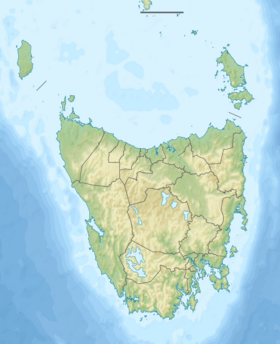Serpentine Dam (Tasmania) facts for kids
Quick facts for kids Serpentine Dam |
|
|---|---|
|
Location of the Serpentine Dam in Tasmania
|
|
| Country | Australia |
| Location | South West Tasmania |
| Coordinates | 42°46′35″S 145°58′56″E / 42.77639°S 145.98222°E |
| Purpose | Power |
| Status | Operational |
| Opening date | 1971 |
| Owner(s) | Hydro Tasmania |
| Dam and spillways | |
| Type of dam | Embankment dam |
| Impounds | Serpentine River |
| Height | 38 metres (125 ft) |
| Length | 134 metres (440 ft) |
| Dam volume | 127×103 m3 (4.5×106 cu ft) |
| Spillways | 1 |
| Spillway type | Controlled |
| Spillway capacity | 242 m3/s (8,500 cu ft/s) |
| Reservoir | |
| Creates | Lake Pedder |
| Total capacity | 2,937,930 ML (103,752×106 cu ft) |
| Catchment area | 734 km2 (283 sq mi) |
| Surface area | 242 km2 (93 sq mi) |
| Maximum water depth | 43 m (141 ft) |
The Serpentine Dam is a rockfill embankment dam with a concrete face and a controlled spillway across the Serpentine River, located in the South West region of Tasmania, Australia.
The impounded reservoir, also formed with the Edgar Dam and the Scotts Peak Dam, is called Lake Pedder which flooded Lake Edgar, a naturally forming fault scarp pond. The dam was constructed in 1971 by the Hydro Electric Corporation (TAS) as part of the Gordon River Power Development Scheme for the purpose of generating hydro-electric power via the conventional Gordon Power Station. Water from Lake Pedder is diverted to Lake Gordon (formed by the Gordon Dam) via the McPartlan Pass Canal.
Location and features
The Serpentine Dam, together with the Edgar Dam and the Scotts Peak Dam, are three major dams that form the headwaters for the Gordon River Power Development Scheme. The dam is located near Lake Pedder's most northwesterly point where the Serpentine River descends from the Frankland Range into what is now known as the Pedder Reach. At the southern end of the Lake Pedder, the Scotts Peak Dam impounds the upper reaches of the Huon River. The Edgar Dam forms a saddle dam at Lake Pedder's most easterly point. The water in Lake Pedder provides around 40% of the water used in the Gordon Power Station. The water flows to Lake Gordon via McPartlan Canal. Water from Lake Gordon then exits through the Gordon Power Station releasing via the tailrace into the Gordon River.
Built on a foundation of rock and soil, the Serpentine Dam wall was constructed with 127 thousand cubic metres (4.5×106 cu ft) of rockfill and faced with concrete. The dam wall is 38 metres (125 ft) high and 134 metres (440 ft) long. At 100% capacity the dam wall holds back 2,937,930 megalitres (103,752×106 cu ft) of water. The surface area of Lake Pedder is 241,330 hectares (596,300 acres) and the catchment area is 734 square kilometres (283 sq mi). The dam wall has a controlled spillway capable of discharging 242 cubic metres per second (8,500 cu ft/s).
This non-hydroelectric dam helps retain water in the new impoundment, which then flows to Lake Gordon via the McPartlans Pass Canal at 42°50′51″S 146°11′45″E / 42.84750°S 146.19583°E.
The construction of the Serpentine Dam resulted in the loss of one of the significant sub-populations of the endangered Centrolepis pedderensis, while the nearby Gordon Dam caused the loss of another. It is now only known to exist in one location on the Frankland Range. One sub-population existed along the Serpentine River and is now inundated as a direct cause of the creation of this dam.


